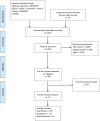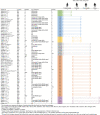Body size preferences for women and adolescent girls living in Africa: a mixed-methods systematic review
- PMID: 33593472
- PMCID: PMC9991778
- DOI: 10.1017/S1368980021000768
Body size preferences for women and adolescent girls living in Africa: a mixed-methods systematic review
Abstract
Objective: To synthesise evidence on body size preferences for females living in Africa and the factors influencing these.
Design: Mixed-methods systematic review including searches on Medline, CINHAL, ASSIA, Web of Science and PsycINFO (PROSPERO CRD42015020509). A sequential-explanatory approach was used to integrate quantitative and qualitative findings.
Setting: Urban and rural Africa.
Participants: Studies of both sexes providing data on body size preferences for adolescent girls and women aged ≥10 years.
Results: Seventy-three articles from twenty-one countries were included: fifty quantitative, fifteen qualitative and eight mixed methods. Most studies reported a preference for normal or overweight body sizes. Some studies of adolescent girls/young women indicated a preference for underweight. Factors influencing preferences for large(r) body sizes included: socio-demographic (e.g. education, rural residency), health-related (e.g. current BMI, pubertal status), psycho-social (e.g. avoiding HIV stigma) and socio-cultural factors (e.g. spouse's preference, social standing, cultural norms). Factors influencing preferences for slim(mer) body sizes included: socio-demographic (e.g. higher socioeconomic status, urban residency, younger age), health-related (e.g. health knowledge, being nulliparous), psycho-social (e.g. appearance, body size perception as overweight/obese) and socio-cultural factors (e.g. peer pressure, media).
Conclusions: Preference for overweight (not obese) body sizes among some African females means that interventions need to account for the array of factors that maintain these preferences. The widespread preference for normal weight is positive in public health terms, but the valorisation of underweight in adolescent girls/young women may lead to an increase in body dissatisfaction. Emphasis needs to be placed on education to prevent all forms of malnutrition.
Keywords: Adolescent girls; Africa; Body size preferences; Review; Women.
Figures





Similar articles
-
Home treatment for mental health problems: a systematic review.Health Technol Assess. 2001;5(15):1-139. doi: 10.3310/hta5150. Health Technol Assess. 2001. PMID: 11532236
-
Measures implemented in the school setting to contain the COVID-19 pandemic.Cochrane Database Syst Rev. 2022 Jan 17;1(1):CD015029. doi: 10.1002/14651858.CD015029. Cochrane Database Syst Rev. 2022. Update in: Cochrane Database Syst Rev. 2024 May 2;5:CD015029. doi: 10.1002/14651858.CD015029.pub2. PMID: 35037252 Free PMC article. Updated.
-
Factors that influence parents' and informal caregivers' views and practices regarding routine childhood vaccination: a qualitative evidence synthesis.Cochrane Database Syst Rev. 2021 Oct 27;10(10):CD013265. doi: 10.1002/14651858.CD013265.pub2. Cochrane Database Syst Rev. 2021. PMID: 34706066 Free PMC article.
-
Progressive resistive exercise interventions for adults living with HIV/AIDS.Cochrane Database Syst Rev. 2004 Oct 18;(4):CD004248. doi: 10.1002/14651858.CD004248.pub2. Cochrane Database Syst Rev. 2004. PMID: 15495092
-
Conceptual framework and systematic review of the effects of participants' and professionals' preferences in randomised controlled trials.Health Technol Assess. 2005 Sep;9(35):1-186, iii-iv. doi: 10.3310/hta9350. Health Technol Assess. 2005. PMID: 16153352
Cited by
-
What, when, and how food and beverage are advertised on Ghanian television.PLoS One. 2025 Jun 9;20(6):e0325730. doi: 10.1371/journal.pone.0325730. eCollection 2025. PLoS One. 2025. PMID: 40489504 Free PMC article.
-
Rapid review of factors influencing dietary behaviors in Fiji.Front Nutr. 2023 Aug 9;10:1164855. doi: 10.3389/fnut.2023.1164855. eCollection 2023. Front Nutr. 2023. PMID: 37621737 Free PMC article. Review.
-
Associations between disordered eating behaviour and sexual behaviour amongst emerging adults attending a tertiary education institution in Coastal Kenya.PLoS One. 2024 Jun 11;19(6):e0301436. doi: 10.1371/journal.pone.0301436. eCollection 2024. PLoS One. 2024. PMID: 38861516 Free PMC article.
-
Physical activity, lifestyle, sociocultural factors and prevalence of excess weight gain among postmenopausal women: A cross-sectional study.Womens Health (Lond). 2023 Jan-Dec;19:17455057231184508. doi: 10.1177/17455057231184508. Womens Health (Lond). 2023. PMID: 38099449 Free PMC article.
-
Addressing childhood obesity in Iran: exploring a multifaceted conceptual model in a low/middle income country through stakeholder lens.BMC Public Health. 2025 Feb 25;25(1):772. doi: 10.1186/s12889-024-21221-1. BMC Public Health. 2025. PMID: 40001077 Free PMC article.
References
-
- Development Initiatives (2020) Global Nutrition Report 2020: Action to Equity to End Malnutrition. Bristol, UK: Development Initiatives.
-
- Prentice AM (2006) The emerging epidemic of obesity in developing countries. Int J Epidemiol 35, 93–99. - PubMed
-
- Gatineau M & Mathrani S (2011) Ethnicity and obesity in the UK. Perspect Public Health 131, 159–160. - PubMed
Publication types
MeSH terms
LinkOut - more resources
Full Text Sources
Other Literature Sources
Research Materials
Miscellaneous

